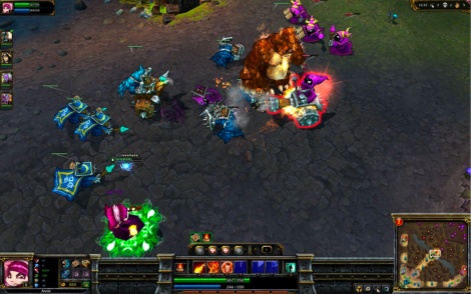Intrinsic in-game advertising is nothing new. But over the past year, the popularity of in-game ads has been sweeping across both indie and AAA studios, from mobile to PC and the metaverse, with examples seen in titles ranging from Cooking Diary to Dakar Desert Rally.
So what do some of the world’s biggest names in gaming think about the in-game advertising phenomenon, and how does it lend itself to modern studios’ monetisation efforts?
To find out, Anzu asked Marc Merrill, President of Games, Co-Founder, and Co-Chairman at Riot Games, to share his thoughts, advice, and predictions for the future of in-game during a live discussion with Anzu’s Co-Founder & CEO, Itamar Benedy.
Why does intrinsic in-game work so well for modern mobile games?
Itamar began the discussion around Marc Merrill’s personal investment in Anzu. “What we’re trying to do at Anzu is balance the art of the game — we call it ‘letting gamers play’ — versus allowing brands to communicate in a positive way with a wide array of audiences,” Itamar started. “How do you specifically see in-game advertising?”
“From a macro perspective, given the amount of engagement, there’s clearly an opportunity,” replied Marc. “That doesn’t mean there’s a one-size-fits-all, perfect solution. Each game needs to be thoughtfully and deliberately curated to ensure the advertising looks like it enhances the in-game experience, elevating it for players.”
Marc continued that by following this rule, developers will open their games to more brand opportunities while making players feel good and appreciative of the new experiences, rather than feeling exploited or that the gameplay was cheapened in some way.

Does intrinsic in-game balance out with other monetisation methods?
While intrinsic in-game advertising is one type of monetisation for game development studios, Marc emphasised that this isn’t the only option for publishers. “Certain types of games, like various mobile games, have very different business models, with a mixture of ads and loading screens”, he explained, “so there are also ways that certain companies can find to enhance value to players by leveraging advertising to then not have players pay directly, which of course can also feel good for players.”
Many gaming studios now choose a range of different monetisation methods to maximise revenues from various audiences, who may interact differently with various gaming monetisation content. For instance, Oddshot Games’ popular free-to-play PC title Slapshot: Rebound opted to include intrinsic in-game advertising within their monetisation model, with the flexibility to mix and match with other options to suit the studio. Not only that, these placements allowed the studio to feature both video and display ads within the same placements, mirroring what people may see in a real-life ice hockey arena while helping them to maximise their revenues.
In fact, intrinsic in-game is now becoming more and more necessary for the survival of many studios. To compete with some of the world’s most popular free-to-play games — including Fortnite and PUBG with over 630M players between them — studios are having to get more creative and flexible with how they can monetise their titles without putting off players with a hefty price tag upfront.

How do players react to intrinsic in-game advertising in their favourite games?
While you might initially expect negative reactions from player bases exposed to intrinsic in-game advertising, there is a litany of evidence to counter this argument. Last year, Anzu released its proprietary research into UK and US gamers, which found that seven in 10 support in-game advertising to some extent - with the caveat that the advertising was contextually relevant while remaining true to the game’s environment to preserve the immersive gameplay experience. This aligns with Anzu’s commitment to non-clickable, non-interruptive ads.
Marc recounted this sentiment in a talk that he presented at UCLA a number of years ago. “After speaking in class, this woman came up to me and said, "I just wanted to say thank you, because I've been playing League [of Legends] for seven years and I've never spent a dollar in the game!" She was just grateful for being able to have hundreds or thousands of hours of engagement - she said all her friends that she made at UCLA were because of this game - and it enabled the interaction to continue because the game was free.
“She was even saying, "I wish you guys had ads in the game, or there were other things that I could do to help the company", because she felt grateful for the amount of value that she was getting, despite the fact that she never paid anything.”
Marc continued that when thoughtfully applied, in-game advertising garners that sentiment across many players, and he believed many game developers and advertisers have a similar approach and perspective. “As long as companies and brands are looking at in-game advertising and sponsorship through a curated lens to enhance the player experience, there's a lot of value to unlock that is a win for players, a win for the company, and a win for the brands that want to reach these players in authentic ways.”

Creating an ad platform with game developers in mind
As developers often juggle limited resources and boundless new ideas and features to add to their games, monetisation can sometimes be very difficult to prioritise, Marc explained, due to the complexities of building relationships, curating the ads, and extensive processes involved. “So there’s a lot of value for a platform like Anzu that manages the process in a thoughtful, effective way,” he continued, “with great technology that can be the bridge between advertisers and sponsors and game companies. Without [Anzu’s] tech platform for many companies, and many games, they wouldn't be able to capture the opportunity to deliver that type of value to the audience they're trying to reach.”
Itamar agreed, calling the setup a win-win-win scenario for development studios looking for strategic partnerships to access campaigns from global brands. “Working for a lot of game developers in mobile and PC, [adding intrinsic in-game] ads not only gave them this new revenue model but actually increased engagement in the game, because now it's cooler and looks better.”
Itamar then went on to describe how the perception of gaming has changed since advertising first landed on gamers’ screens, using the example of Mercedes’ business model of charging gaming companies to feature Mercedes and Daimler content in their games to give the titles more credibility. Now, gaming studios have since turned the tables, with advertisers now paying publishers for the privilege of featuring in new and exciting games.
These changing attitudes from advertisers show no signs of slowing down — one publication even described intrinsic in-game advertising as “poised for a growth spurt” in 2023. And as more developers and big names like Marc Merrill support the implementation of intrinsic in-game ads across the gaming landscape, it’s only a matter of time before the channel matures into a ‘League’ of its own.






















